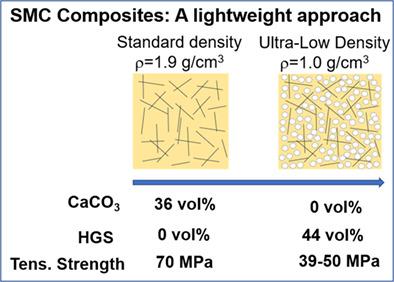当前位置:
X-MOL 学术
›
Polym. Compos.
›
论文详情
Our official English website, www.x-mol.net, welcomes your feedback! (Note: you will need to create a separate account there.)
Hollow glass spheres in sheet molding compound composites: Limitations and potential
Polymer Composites ( IF 5.2 ) Pub Date : 2020-12-04 , DOI: 10.1002/pc.25900 Arielle Berman 1 , Edward DiLoreto 2 , Robert J. Moon 3 , Kyriaki Kalaitzidou 1, 2
Polymer Composites ( IF 5.2 ) Pub Date : 2020-12-04 , DOI: 10.1002/pc.25900 Arielle Berman 1 , Edward DiLoreto 2 , Robert J. Moon 3 , Kyriaki Kalaitzidou 1, 2
Affiliation

|
Sheet molding compounds (SMC) are commonly used in automotive applications as they lead to increased fuel efficiency of vehicles due to their high strength to weight ratios. This study focuses on understanding the effect of replacing calcium carbonate (CaCO3) with hollow glass spheres (HGS) in an unsaturated polyester resin matrix SMC composite with the ultimate goal to further reduce density without compromising performance. The resulting glass fiber (GF)‐reinforced syntactic foam laminate composites with GF content ranging from 10 to 15 vol% have densities of 1.2 and 1 g/cm3, respectively. This is significantly lower than the industry standard SMC density of 1.9 g/cm3. The HGS parameters of interest are primarily HGS type (S28HS and S32HS), loading level (33–44 vol%), and surface functionalization (methacrylsilane). The syntactic foam composites were characterized in terms of tensile, flexural, and impact properties, and their properties were compared to those of standard density SMC. As expected, the flexural, tensile, and impact properties were compromised with a decrease of density. However, they were higher than the corresponding properties of low‐ and ultra‐low density composites reported in the literature, as we were able to add higher GF content in these low‐density SMC formulations. It was also concluded that methacrylsilanized surface treated HGS showed promise in maintaining the mechanical properties, especially at high sphere loadings. The impact energy of the low‐density formulations was relatively unaffected by HGS type or loading.
中文翻译:

片状模塑料复合材料中的空心玻璃球:局限性和潜力
片状模塑料(SMC)通常用于汽车应用,因为它们具有较高的强度与重量比,从而提高了车辆的燃油效率。这项研究的重点是了解在不饱和聚酯树脂基体SMC复合材料中用空心玻璃球(HGS)代替碳酸钙(CaCO 3)的效果,其最终目标是在不影响性能的前提下进一步降低密度。所得玻璃纤维(GF)增强的复合泡沫层压材料复合材料的GF含量为10至15 vol%,密度分别为1.2和1 g / cm 3。这大大低于1.9 g / cm 3的行业标准SMC密度。感兴趣的HGS参数主要是HGS类型(S28HS和S32HS),负载量(33–44 vol%)和表面官能化(甲基丙烯酸硅烷)。通过拉伸,弯曲和冲击性能对复合泡沫复合材料进行了表征,并将其性能与标准密度SMC的性能进行了比较。如预期的那样,弯曲,拉伸和冲击性能受到密度降低的影响。但是,它们高于文献中报道的低密度和超低密度复合材料的相应性能,因为我们能够在这些低密度SMC配方中添加更高的GF含量。还得出结论,甲基丙烯酸硅烷化的表面处理过的HGS在保持机械性能方面表现出了希望,尤其是在高球体载荷下。
更新日期:2020-12-04
中文翻译:

片状模塑料复合材料中的空心玻璃球:局限性和潜力
片状模塑料(SMC)通常用于汽车应用,因为它们具有较高的强度与重量比,从而提高了车辆的燃油效率。这项研究的重点是了解在不饱和聚酯树脂基体SMC复合材料中用空心玻璃球(HGS)代替碳酸钙(CaCO 3)的效果,其最终目标是在不影响性能的前提下进一步降低密度。所得玻璃纤维(GF)增强的复合泡沫层压材料复合材料的GF含量为10至15 vol%,密度分别为1.2和1 g / cm 3。这大大低于1.9 g / cm 3的行业标准SMC密度。感兴趣的HGS参数主要是HGS类型(S28HS和S32HS),负载量(33–44 vol%)和表面官能化(甲基丙烯酸硅烷)。通过拉伸,弯曲和冲击性能对复合泡沫复合材料进行了表征,并将其性能与标准密度SMC的性能进行了比较。如预期的那样,弯曲,拉伸和冲击性能受到密度降低的影响。但是,它们高于文献中报道的低密度和超低密度复合材料的相应性能,因为我们能够在这些低密度SMC配方中添加更高的GF含量。还得出结论,甲基丙烯酸硅烷化的表面处理过的HGS在保持机械性能方面表现出了希望,尤其是在高球体载荷下。



























 京公网安备 11010802027423号
京公网安备 11010802027423号